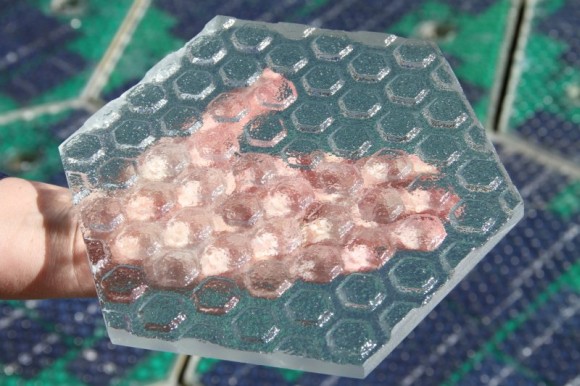Attempting the electrify roads and highways using reinforced solar panels is technically difficult, hence the negative reaction that Scott and Julie Brusaw have received since announcing their start up Solar Roadways campaign. Many feel very strongly against this idea and the couple have experienced outright animosity from almost all quarters.
After a few years of trying to bring their idea to ground, the couple, based in Sandpoint, Idaho, signed a $100,000 deal with the American Department of Transportation to further research and develop Solar Roadways.
This stipend would be used to gather statistics and information from leading engineering professionals within various fields as well as for developing a theory paper based on their findings.
Solar Roadways start-up receives backlash from skeptics
February 2010 was the year the Brusaws developed and conceived a first panel (12ft by 12ft array that didn’t contain solar cells) to test if the elemental electronics would work.
Within that same year, their company won another $50,000 through a community award initiative challenge called the GE’s Ecomagination, which added into their funds to keep testing and researching.
During 2011, The Department of Transportation followed their initial stipend with a further $750,000 towards Solar Roadways in order to aid in their creation of a second demonstration array that would contain solar cells, LED light as well as a built in heating system.
The role of the Department of Transportation was not just as a money lender, but as a partner in testing the arrays in order to ensure that they were safe, working and able to withstand negative environmental and road conditions.
Department of Transportation supports development of Solar Roadways
When questioned about the plan to reform America’s highways into solar-powered LED roadways, Eric Weaver (a research engineer at the Federal Highway Administration’s research and technology department who led the testing of this project) had this to say; “it’s not very realistic to cover the entire highway system with these panels.” He was still quick to clarify further; “If you don’t reach for something, you’ll never get there. Just the effort of doing something new creates by-products.”
Deciding that they needed further financial investment, Solar Roadways turned to crowd funding in order to raise the money needed. This was a very successful campaign which brought in $2.2 million. Due to the success of this drive, many thought the project is scam and the couple once more received heavy criticism from many people.
The Department of Transportation has come to Solar Roadways defence through an interview with Greentech Media by acknowledging the fact that even though Solar Roadways had made big claims about the potential of their technology through an Indiegogo video, the company is legit. Their products have been through vigorous testing that have accomplished early-stage products for demonstrations.
Main concerns for technology include safety and long term durability
The issues faced by such technology include safety and durability. Driving or walking in a glass surface is very different than doing so on asphalt; hence the fact the Department of Transportation still has many more rounds of testing before it can comment on its effectiveness.
Solar Roadways has released results from a test conducted on both wet and textured glass surface at a university lab, which has shown that a vehicle going 80 miles an hour can stop in time. However, receiving approval from a university is completely different from receiving it from highway authorities.
“We have no idea how it would hold up to wear under foot or car traffic,” said Weaver, though the Department of Transportation has used a weight deflectometer to test impact loads of close to 16,000 pounds by using a 3D modelling analysis (they couldn’t get their equipment through to Solar Roadways headquarters).
Material restricitions another limitation to potential widespread rollout
The third untested part of this technology is the availability of equipment and materials that are needed. Sourcing large circuits to place under the glass is very difficult as every company has developed smaller circuits instead of going bigger.
“They spent a lot of time trying to get the circuitry embedded in the glass. But issues with the prototype could be overcome with larger-scale automated production,” said Weaver.
Brusaw has admitted to several challenges, but he adds that a lot of those have been worked through already. He plans to take upon new rounds of testing through university labs or through the Department of Transportation for better simulations. Solar Roadways have the option of continuing their relationship with the Department of Transportation for phase three or using their Indiegogo funds to aid in further testing.
The one important technical aspect that has not yet been verified as well is the performance of the solar cells themselves.
As all testing (monitored by Enphase micro inverters) has been done at the Brusaw’s home, they cannot be verified by an independent source, it’s impossible to understand how the solar part of the road will function over a period of time.
So with the above challenges still not resolved, what is the future of paving America’s highways with solar looking like? Weaver has answered this question as diplomatically as possible, by stating that even though the Department of Transportation is not close to rolling the system out, he still does not dismiss this concept completely.
Sheer amount of limitations make Solar Roadways intended future unlikely
“I believe the application can be used for smaller scale purposes — potentially, pedestrian walkways and sidewalks that get lower load and have fewer safety considerations,” he said. “For roads, there are so many unknowns.”
On behalf of Solar Roadways, Brusaw has stated that they wouldn’t allow for the installation, permitting or servicing of the panel. This would be led by manufacturers and service providers or even the allow for the government to work out how to build and finance projects. Besides the technical limitations, there are also complex networks of private, state and federal regulations to navigate through regarding transportation and planning.
Solar Roadways do have short-term applications that they plan to utilise such as the project in Sandpoint, Idaho. The aim of this is to create 5 pilot programs regarding non-critical applications, such as downtown sidewalks etc. Data streaming non-stop for a year about its performance will be streamed to the public to monitor.
While the second application could be built on tribal lands (these have their own rules etc.) whereby a parking-lot scale project could be installed at a casino or similar commercial outfitting.
Small-scale projects seen as the future for this futuristic concept
The next step for Solar Roadways is hiring extra engineers to supplement the part-time graduates that have been helping the couple; “I need some more people under my roof. I want to put them in a room and figure out how to make it work.”
As it stands though, the one and only roadway run by solar is a 12-foot by 36-foot group of panels located at the couple’s barn in Idaho that tractors are driving over daily. As you can see, the project or rather the idea is nowhere near completion and perhaps it will never will get there.
Many silent investors who have dream and hopes as well as money invested into the company will have to contend with waiting an indefinite amount of time to find out if anything substantial will be accomplished with their investments.
In the words of Mr Weaver; “in terms of the long-term vision, I don’t consider it to be realistic. But I enjoy the vision and appreciate it, and will try to support them to see what other benefits may present themselves.”
Photo by: Pomah Magician on Flickr

